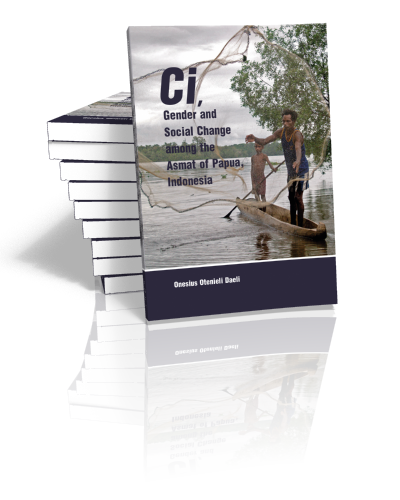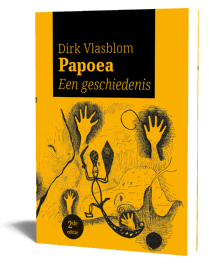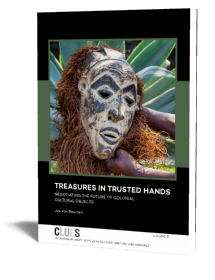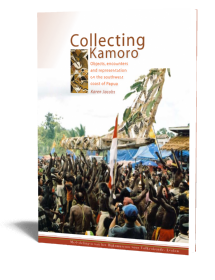Ci, Gender and Social Change among the Asmat of Papua, Indonesia
Onesius Otenieli Daeli | 2020

Ci, Gender and Social Change among the Asmat of Papua, Indonesia
Onesius Otenieli Daeli | 2020
Paperback ISBN: 9789088909290 | Hardback ISBN: 9789088909306 | Imprint: Sidestone Press | Format: 182x257mm | 168 pp. | Language: English | 46 illus. (bw) | 25 illus. (fc) | Keywords: Asmat; Papua; Ci; dugout canoe; Gender; Social change; Symbol; Identity | download cover
Read online or downloaded 2220 times
-
Digital & Online access
This is a full Open Access publication, click below to buy in print, browse, or download for free.
-
Buy via Sidestone (EU & UK)
-
Buy via our Distributors (WORLD)
For non-EU or UK destinations you can buy our books via our international distributors. Although prices may vary this will ensure speedy delivery and reduction in shipping costs or import tax. But you can also order with us directly via the module above.
UK international distributor
USA international distributor
-
Bookinfo
Paperback ISBN: 9789088909290 | Hardback ISBN: 9789088909306 | Imprint: Sidestone Press | Format: 182x257mm | 168 pp. | Language: English | 46 illus. (bw) | 25 illus. (fc) | Keywords: Asmat; Papua; Ci; dugout canoe; Gender; Social change; Symbol; Identity | download cover
Read online or downloaded 2220 times

We will plant a tree for each order containing a paperback or hardback book via OneTreePlanted.org.
Ci is the Asmat word for dugout canoe. The ci is an integral part of the everyday life of the Asmat – an ethnic group residing in eastern Indonesia in Papua province (formerly Irian Jaya) – who live in the middle of a huge tidal swampy area. Owning a ci is part of the Asmat’s habitus because ci is a guarantee for mobility, both individually and collectively. The ci is essential for the everyday lives of the Asmat. However, the existence of these dugout canoes is now critical as they tend to be replaced by machinery boats.
This book uses a very simple piece of material culture, the ci, to introduce readers to the Asmat people and inform them how the Asmat people live. The ci becomes the focal point to understand gender power relations among the Asmat, particularly through social, economic, and spiritual dimensions. This volume is based on an anthropological fieldwork among the Asmat people for many years, and investigates the cultural significances of Asmat’s ci by using ‘symbolic and interpretive anthropology’ as theoretical framework.
Foreword
Acknowledgments
Table of contents
List of illustrations
List of acronyms
Introduction
I. Asmat: an exotic and nostalgic world
1.1 The ci: an Asmat’s habitus
1.2 Back to Asmat with new eyes
1.3 Learning to know, learning to preserve
1.4 Story from the field
1.5 Scope and limitations
1.6 Analytical framework used
II. The ci: a significant key to understand Asmat
2.1 Select literature on the Asmat
2.2 The ci: the Asmat canoe
2.3 Gender power relations
III. The Asmat: a never ending surprise
3.1 Asmat: a pregnant swamp of natural resources
3.2 Asmat in Papua province of Indonesia
3.3 Asmat: a region that contains no stone
3.4 Asmat art: an anamnesis
3.5 Defining the Asmat people
3.6 Asmat: people of the tree
3.7 Warfare and headhunting practices
3.8 Some impressions about kinship
3.9 Mission “touch”
IV. Physical dimension of the ci
4.1 The ci material
4.2 Understanding the ci through its sections
4.3 Types of ci
4.3.1 Pakanam ci
4.3.2 Jicap ci or pakman ci
4.4 Interpretations of the carvings of the ci
4.5 Bottomless ci
4.6 Po: the Asmat oar
V. Social dimension of the ci
5.1 The sociality of the ci
5.2 Cisi-ipits – ci maker
5.3 The ci owned by the family
5.4 The ci triggers conflicts among the Asmat
5.5 The dynamics of ci cimen and ci ep
5.6 Rowing the ci
5.7 Social dimension of the jicap ci
5.8 Social dimension of wuramon
5.9 Ci as an expression of art
5.10 The ci: symbol of masculinity
5.11 The ci: a dominant symbol of gender identity
VI. Spiritual dimension of the ci
6.1 Naming the ci
6.2 A distinct ci: wuramon
VII. Economic dimension of the ci
7.1 Ci opak, jis opak – no ci, no firewood
7.2 Ci for men, jouse for women
7.3 Power over dusun
7.4 Do not call him bitni
7.5 One family in one ci
7.6 The ci: a key for Asmat economy and festive activity
VIII. Continuity and discontinuity in Asmat society
8.1 Social change
8.2 Water transportation is still needed
8.3 Pes (ironwood) and ci nak (ci tree) are in danger
8.4 The changed meaning and function of ritual
8.5 Carving: not because of inspiration, but because of order
8.6 Money-oriented mentality
8.7 Asmat nak – the real people
8.8 New style of hunting and gathering
8.9 The changed concept of gender
8.10 Urbanization: dusun and village unmaintained
8.11 Marginalization of the Asmat in many aspects
IX. Reflection and conclusion
9.1 Reflections as a priest and as researcher in the field
9.2 Advantages
9.3 Disadvantages
9.4 Conclusion
9.5 For future research
Bibliography
Glossary of terms

Dr. Onesius Otenieli Daeli
Onesius Otenieli Daeli is an ordained Roman Catholic priest and a member of the Order of the Holy Cross (Ordo Sanctae Crucis), born in Nias, North Sumatera, Indonesia. He spent more than five years (2002 – 2008) among the Asmat people. He was participating in many aspects of the Asmat life, including rituals, traditional feasts, rural economy, and politics.
Abstract:
Ci is the Asmat word for dugout canoe. The ci is an integral part of the everyday life of the Asmat – an ethnic group residing in eastern Indonesia in Papua province (formerly Irian Jaya) – who live in the middle of a huge tidal swampy area. Owning a ci is part of the Asmat’s habitus because ci is a guarantee for mobility, both individually and collectively. The ci is essential for the everyday lives of the Asmat. However, the existence of these dugout canoes is now critical as they tend to be replaced by machinery boats.
This book uses a very simple piece of material culture, the ci, to introduce readers to the Asmat people and inform them how the Asmat people live. The ci becomes the focal point to understand gender power relations among the Asmat, particularly through social, economic, and spiritual dimensions. This volume is based on an anthropological fieldwork among the Asmat people for many years, and investigates the cultural significances of Asmat’s ci by using ‘symbolic and interpretive anthropology’ as theoretical framework.
Contents
Foreword
Acknowledgments
Table of contents
List of illustrations
List of acronyms
Introduction
I. Asmat: an exotic and nostalgic world
1.1 The ci: an Asmat’s habitus
1.2 Back to Asmat with new eyes
1.3 Learning to know, learning to preserve
1.4 Story from the field
1.5 Scope and limitations
1.6 Analytical framework used
II. The ci: a significant key to understand Asmat
2.1 Select literature on the Asmat
2.2 The ci: the Asmat canoe
2.3 Gender power relations
III. The Asmat: a never ending surprise
3.1 Asmat: a pregnant swamp of natural resources
3.2 Asmat in Papua province of Indonesia
3.3 Asmat: a region that contains no stone
3.4 Asmat art: an anamnesis
3.5 Defining the Asmat people
3.6 Asmat: people of the tree
3.7 Warfare and headhunting practices
3.8 Some impressions about kinship
3.9 Mission “touch”
IV. Physical dimension of the ci
4.1 The ci material
4.2 Understanding the ci through its sections
4.3 Types of ci
4.3.1 Pakanam ci
4.3.2 Jicap ci or pakman ci
4.4 Interpretations of the carvings of the ci
4.5 Bottomless ci
4.6 Po: the Asmat oar
V. Social dimension of the ci
5.1 The sociality of the ci
5.2 Cisi-ipits – ci maker
5.3 The ci owned by the family
5.4 The ci triggers conflicts among the Asmat
5.5 The dynamics of ci cimen and ci ep
5.6 Rowing the ci
5.7 Social dimension of the jicap ci
5.8 Social dimension of wuramon
5.9 Ci as an expression of art
5.10 The ci: symbol of masculinity
5.11 The ci: a dominant symbol of gender identity
VI. Spiritual dimension of the ci
6.1 Naming the ci
6.2 A distinct ci: wuramon
VII. Economic dimension of the ci
7.1 Ci opak, jis opak – no ci, no firewood
7.2 Ci for men, jouse for women
7.3 Power over dusun
7.4 Do not call him bitni
7.5 One family in one ci
7.6 The ci: a key for Asmat economy and festive activity
VIII. Continuity and discontinuity in Asmat society
8.1 Social change
8.2 Water transportation is still needed
8.3 Pes (ironwood) and ci nak (ci tree) are in danger
8.4 The changed meaning and function of ritual
8.5 Carving: not because of inspiration, but because of order
8.6 Money-oriented mentality
8.7 Asmat nak – the real people
8.8 New style of hunting and gathering
8.9 The changed concept of gender
8.10 Urbanization: dusun and village unmaintained
8.11 Marginalization of the Asmat in many aspects
IX. Reflection and conclusion
9.1 Reflections as a priest and as researcher in the field
9.2 Advantages
9.3 Disadvantages
9.4 Conclusion
9.5 For future research
Bibliography
Glossary of terms

Dr. Onesius Otenieli Daeli
Onesius Otenieli Daeli is an ordained Roman Catholic priest and a member of the Order of the Holy Cross (Ordo Sanctae Crucis), born in Nias, North Sumatera, Indonesia. He spent more than five years (2002 – 2008) among the Asmat people. He was participating in many aspects of the Asmat life, including rituals, traditional feasts, rural economy, and politics.
-
Digital & Online access
This is a full Open Access publication, click below to buy in print, browse, or download for free.
-
Buy via Sidestone (EU & UK)
-
Buy via our Distributors (WORLD)
For non-EU or UK destinations you can buy our books via our international distributors. Although prices may vary this will ensure speedy delivery and reduction in shipping costs or import tax. But you can also order with us directly via the module above.
UK international distributor
USA international distributor
- Browse all books by subject
-
Search all books

We will plant a tree for each order containing a paperback or hardback book via OneTreePlanted.org.
You might also like:
© 2026 Sidestone Press KvK nr. 28114891 Privacy policy Sidestone Newsletter Terms and Conditions (Dutch)








